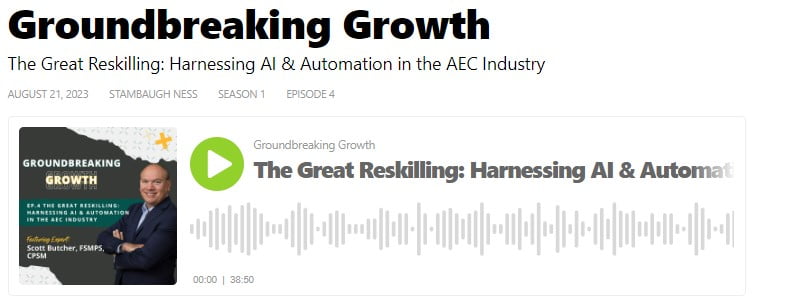Construction Upskilling: Future-Proof Your Workforce

Most of us can think back to a time (or have heard stories of) when construction layout meant weeks or months on-site with a chain and tape, literally turning angles. Flash forward to today, where layout means and methods have drastically evolved. Technological advancements and how we deliver work aren’t slowing down. Every construction firm will need to upskill their workforce to take advantage of these changing advancements – from the field to project management and estimating to our HR, Marketing, and IT team members.
But the skills required to do our work aren’t just technical in nature; to successfully build and manage work interacting with teams of colleagues and clients is critical. As a company, how do you identify the required skill sets to deliver work in the future and ensure your employees can develop these skills – do you leave it to chance, or do you have a plan?
To upskill employees effectively, firms must perform skills assessments and identify and prioritize talent gaps to stay competitive in the ever-changing business landscape.
Here is a look at the top trends driving the need for upskilling the construction workforce.
Technology
The construction industry is often looked down upon as a slow adopter of technology – but that trend is changing, and technology is here to stay. As leaders, we need to take a realistic look at our organizations and what our current and new employee’s skills are related to tech. The technology skills that recent graduates have learned may or may not align with the technology being used in the organization. Those who have been in the workforce for 5, 10, or 20+ years will need to be trained on the newer technologies as they’re introduced. This cross-generation impact is an example of why upskilling in the construction workforce often can’t be a one-size fits all approach.
Artificial Intelligence and Robotics
Robotics and AI are a unique subset of technology as they have the potential to drastically change the way we work. Ideally, they will make jobs easier & safer, but they must be managed and maintained to ensure authenticity and quality in our products and services. Due to these advancements, portions of roles, or whole roles, may change or be eliminated. Still, others will be created, hopefully easing the burden of the physical demands of the construction industry. Leadership will need to balance how to leverage these advancements with the strengths of the current workforce and, if any gaps present themselves, invest in staff development—helping employees to continue to learn and grow, which is what most of us desire.
Transition of Generations
In construction, more than in other industries, we are acutely aware of the changing demographics in the workplace and their potential impacts. To put the trend in perspective, approximately 78 million baby boomers will be retiring partially or fully in the next 5+ years. Building a robust pipeline of skilled trade and industry professionals will be a challenge for years to come. One thing is for sure, multiple generations will continue to move through our organizations, and as a result, skills may come and go. Capturing relevant, critical skills will be essential for organizations to keep their competitive advantage. Technical skills are important, but more attention should be placed on capturing and transitioning the experiences accumulated, critical thinking ability, problem-solving skills, and established business and client relationships.
Some of this process will happen naturally through pairing up different individuals on projects, etc., but intentionally doing more of it will yield the best return on investment.
Next Steps
Now more than ever, it is critical to inventory what skills exist in the organization and which ones will be needed as the organization moves into the future. This assessment helps define learning and development priorities and highlight potential new skills that must be brought in when hiring new employees. Pairing this with career paths is a competitive advantage when recruiting and retaining talent. We invite you to join our upcoming webinar, where we will discuss handling skills gaps, building meaningful career paths, and more.




